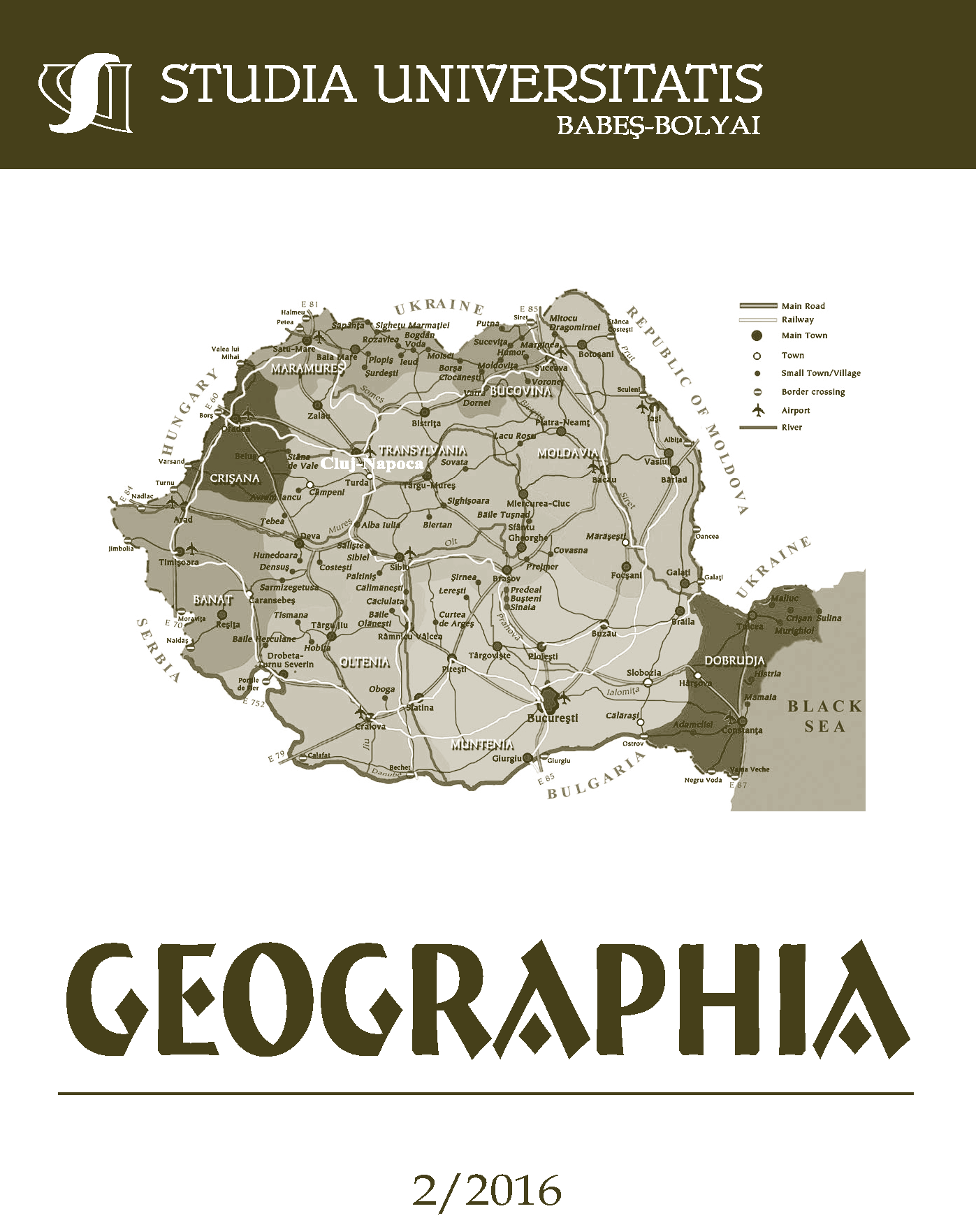LANDSLIDE SUSCEPTIBILITY EVALUATION USING GIS. CASE STUDY: SILVANIA HILLS (ROMANIA)
Keywords:
natural hazard, landslide, susceptibility analysis, mapping susceptibility, database, MaxEnt model, Silvania Hills, GIS, ROC curve.Abstract
Landslide Susceptibility Evaluation Using GIS. Case Study: Silvania Hills (Romania). Landslides are destructive natural or human-induced hazards, therefore an assessment of landslide susceptibility becomes essential in an area that is prone to landslide through its geographical features. Landslide susceptibility maps provide valuable information for disaster mitigation works and land planning strategies. Silvania Hills are highly prone to landslide due their lithological and geomorphological structure. The purpose of this paper is to prepare a reliable landslide susceptibility map, which was obtained using the maximum entropy model. The model was run considering twelve environmental factors: lithology, slope, aspect, land use, land cover type, precipitation, temperature, terrain roughness, depth of fragmentation, drainage density, profile and plan curvature. The resulting map was grouped into five landslide susceptibility classes: very low, low, moderate, high and very high class. The results indicated that the land use and -cover type, slope and depth of fragmentation are the three most influential landslide predisposing factors. The accuracy of the resulted map was verified by generating a receiver operating characteristic (ROC) curve. The area under the curve (AUC) showed a good performance (0.847) of the analysis.
References
Arghiuș, C. (2010). Culmea și Piemontul Codrului. Studiu geomorphologic, PhD. Thesis, Universitatea Babeș-Bolyai, Facultatea de Geografie, Cluj-Napoca.
Bayes, A. (2015). Landslide susceptibility modelling applying user-defined weighting and data-driven statistical techniques in Cox’s Bazar Municipality, Nat Hazards, pp. 1707-1737.
Bilașco, Ș., Horvath, CS., Roșian, Gh., Filip, S., Keller, I.E. (2011). Statistical model using GIS for the assessment of landslide susceptibility. Case study: The Someş plateau, Romanian Journal of Geography, Romanian Academy Publisher, Bucharest, pp. 91-101.
Blîdiță, V. (2009). Dealurile Crasnei – Studiu de geomorfologie cu privire specială asupra proceselor actuale, PhD Thesis, University of Oradea, Oradea.
Chen, W., Chai, H., Sun, X., Wang, Q., Ding, X., Hong, H. (2016). A GIS-based comparative study of frequency ratio, statistical index and weights-of-evidence models in landslide susceptibility mapping, Arabian Journal of Geosciences.
Chung, C.J.F., Fabbri, A.G. (2003). Validation of spatial prediction models for landslide hazard mapping, Natural Hazards, pp. 451–472.
Conforti, M., Robustelli, G., Muto, F., Critelli, S. (2011). Application and validation of bivariate susceptibility assessment for the Vitraro river catchment (Calabria, south Italy), Natural Hazards.
Davis, J.D., Sims, S.M. (2013). Physical and maximum entropy models applied to inventories of hillslope sediment sources, Journal of Soils and Sediments, pp. 1784–1801.
Davis, J.D., Blesius, L. (2015). A Hybrid Physical and Maximum-Entropy Landslide Susceptibility Model, Entropy.
Elith, J., Phillips, S., Hastie, T., Dudík, M., Chee, Y., Yates, C. (2011). A statistical explanation of MaxEnt for ecologists, Diversity and Distributions Journal, pp. 43–57.
Filip, S., Bilașco, Ș. (2006). Abordarea macroscalară a fenomenelor geomorfologice de risc. Studiu de caz: Depresiunea Chiuzbaia, 2006, Riscuri și catastrofe, pp. 73-82.
Filip, S. (2008) Starea morfodinamică, hazardele și vulnerabilitatea geomorfologică în Depresiunea și Munceii Băii Mari, Riscuri și Catastrofe, pp. 180-193.
Grozavu, A., Pleșcan, S., Patriche, C.V., Mărgărint, M.CI., Roșca, B. (2013). Landslide Susceptibility Assessment: GIS Application to a Complex Mountainous Environment, The Carpathians: Integrating Nature and Society Towards Sustainability, Environmental Science and Engineering, pp. 31-44.
Ielenicz, M., Pătru, I. (2005). Geografia Fizică a României, Edit. Universitară, Bucharest.
Petrea, D., Bilașco, Ș., Roșca, S., Fodorean, I., Vescan, I. (2014). The determination of the Landslide occurrence probability by spatial analysis of the Land Morphometric characteristics (case study: the Transylvanian Plateau), Carpathian Journal of Earth and Environmental Sciences, pp. 91-110.
Philips, J.S., Anderson, R.P., Schapired, R.E. (2005). Maximum entropy modelling of species geographic distributions, Ecological Modelling, pp. 231-260.
Posea, G. (2005). Geomorfologia României: relief - tipuri, geneză, evoluție, regionare, Editura Fundației “România de Mâine”, Bucharest.
Posea, G., Popescu, N., Ielenicz, M. (1974). Relieful României, Editura Științifică Bucharest.
Pop, A.M. (2014). Municipiul Zalău. Morfologia şi amenajarea spaţiului urban, PhD Thesis, Universitatea Babeș-Bolyai, Facultatea de Geografie, Cluj-Napoca.
Pradhan, B., Lee, S. (2010). Delineation of landslide hazard areas on Penang Island, Malaysia, by using frequency ratio, logistic regression, and artificial neural network models, Environmental Earth Sciences, pp. 1037–1054.
Riley, S., Degloria, S., Elliot, R. (1999). A terrain ruggedness index that quantifies topographic heterogeneity, Intermountain Journal of Science, pp. 23-27.
Schernthanner, H. (2005). Fuzzy logic approach for landslide susceptibility mapping, “Rio Blanco”, Nicaragua, Unpublished Master Thesis for the Institute of Geography, University of Salzburg.
Surdeanu, V. (1998). Geografia terenurilor degradate, Edit. Presa Universitară Clujeană, Cluj-Napoca, p 274.
Swets, J.A. (1988). Measuring the accuracy of diagnostics systems, Science, pp. 1285-1293.
Zaharia, S., Driga, B., Chendeș, V. (2011). Evaluation of the probable susceptibility to landslide in the municipality of Baia Mare (Maramureș County), Riscuri și Catastrofe, pp. 120-130.
Downloads
Published
How to Cite
Issue
Section
License
Copyright (c) 2016 Studia Universitatis Babeș-Bolyai Geographia

This work is licensed under a Creative Commons Attribution-NonCommercial-NoDerivatives 4.0 International License.





 ©Studia Universitatis Babeş-Bolyai Geographia. Published by Babeș-Bolyai University.
©Studia Universitatis Babeş-Bolyai Geographia. Published by Babeș-Bolyai University.